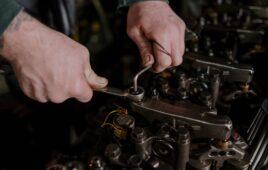By Christie L. Jones, Vice President / Director of Marketing
SPIROL International Corporation, U.S.A.

A solid pin’s rigidity elongates the hole, which leads to premature failure of the pinned joint.
Typically, fasteners are the smallest, least costly components used in an assembly. Perhaps, for this reason, they are rarely considered until the end of a project’s design stage. However, fasteners provide a critical function by holding an entire application together.
As important as fasteners are, however, design engineers rarely receive formal training on the mechanics of fastening and joining. This is particularly concerning in certain safety-critical applications, such as steering columns, brakes, airplane engines, and others.
Adding to the challenge is the sheer volume of fasteners available today. An assembly can be held together in many ways, using a variety of types of bolts, rivets, screws, pins, and other fastening devices.
Assembly methods fall into two broad categories:
- Methods that use two components or two operational steps to stay in place
- Methods where the components are self-retaining

Coiled spring pins (left) and slotted spring pins (right).
The challenge for the majority of design engineers when selecting a method is cost and reliability. Ideally, the goal is to use the highest quality joint at the lowest manufacturing cost.
Self-retaining pins
For many applications, self-retaining pins provide the ideal solution and assembly method. However, choosing the correct pin for an application requires research.
Technically, when a load is applied, something has to give: the pin, the hole, or an element of the assembly. A pin that’s too rigid typically causes the hole in which it is retained to elongate, eventually leading to assembly failure. However, a pin that’s too flexible will fatigue under dynamic loading.
There are several types of pins, so choosing pins with the appropriate strength and flexibility for the application is critical. Solid and spring pins are two common types of self-retaining pins.
Solid pins
Solid pins come in many different forms, including dowel, knurled, and grooved pins. Generally, solid pins are strong and relatively inflexible. They’re unable to absorb shock and dynamic loads and, instead, transmit these forces to the mating components. Before choosing solid pins, it’s important to consider these dynamic forces for an application.

Under load, stress is concentrated at 180 degrees opposite of the gap in slotted pins.
For example, there’s a common perception that solid pins are ideal for heavy-duty applications. This is typically false because of the pin’s inflexibility. Any force applied to a solid pin is transmitted directly to the hole wall (because it’s unable to flex and absorb the force).
This causes the hole diameter to elongate (open up), resulting in reduced retention of the solid pin.
Movement of the pin within the hole can also result from the elongation. In fact, an extremely small change in velocity can result in a large force on the pin (due to F = MV2). This could lead to a pin breaking because of the impact load.
Additionally, depending on the severity of the elongation, the distance between the shear planes can widen to the point where the pin is no longer in shear but in bending, which decreases the strength of the pinned joint (and again, the pin may break).
Although using a softer solid pin material might reduce the host damage, it also reduces the pin’s strength. Alternatively, a heat-treated spring pin provides strength and its inherent flexibility can maximize assembly life in dynamic, heavy-duty applications.
Spring pins
There are two distinct types of spring pins: slotted and coiled spring pins. Both types share features, including flexibility and an ability to accommodate wider hole tolerances (particularly compared to solid pins).
- Slotted pins offer flexibility during installation, which accommodates wider hole tolerance. In turn, this reduces manufacturing costs. However, compared to a coiled pin, slotted pins only flex at 180 degrees from the gap. This may lead to premature failure of a pin subject to dynamic loading. If the gap is closed after installation, the slotted pin essentially becomes a hollow inflexible tube.

Interlocking does not allow for automatic feeding and installation of slotted pins.
Then, the same issue occurs under dynamic loading (similar to solid pins), where the pin ends up transmitting the applied load onto the hole wall. This is a concern in applications with a soft host material, such as aluminum or plastic.
Additionally, it is extremely difficult to automatically feed and install slotted pins that do not have a controlled gap because they can interlock. The most appropriate applications for these types of pins are non-critical assemblies, manufactured out of mild to hardened steel, that are manually assembled.
- Coiled pins were invented to address many of the disadvantages of using slotted pins. They offer design engineers greater strength and flexibility, including an ability to “customize” the pins balance of strength and flexibility to the application. For example, light-duty pins are generally recommended for soft or brittle materials, medium (or standard) duty pins are typically used in mild steel and non-ferrous assemblies, and heavy-duty pins are ideal for use in hardened components. They’re also ideal when space limitations prevent the use of a larger diameter standard duty pin.

A coiled pin flexes under a load to absorb shock and vibration.
Coiled pins are capable of absorbing shock and vibration after insertion, which means they provide a prolonged life in most assemblies. These components are also conducive for automatic feeding and installation. . They can fasten multiple components together (such as to pin a gear and shaft) and be used as hinge, alignment, and stop pins.
Typically, coiled pins are not recommended for use as cam followers (a type of roller designed to follow cam lobe profiles), or where there is a limited length of engagement for the pin. These applications are generally served best by a solid pin with retention features.
As there are several ways to fasten assemblies, it’s important to take advantage of the application engineering services provided by fastener manufacturers. By partnering with industry experts, design engineers can be assured that their assembly will be equipped with a reliable and cost-effective solution for a safe, long-lasting application.





Tell Us What You Think!